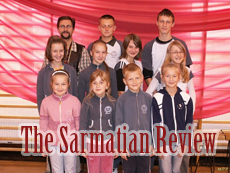| This Issue | Back Issues | Editorial Board | Contact Information |

Books and Movies Received
January 2010
Volume XXX, No. 1
Gran Torino. Directed by and starring Clint Eastwood. Nick Schenk (screenplay) and Dave Johannson (story). Released 9 January 2009.
The film starts with the funeral of Dorothy Kowalski and ends with the funeral of her husband Walter Kowalski. Walter is truly and justly upset with the world. It does not enrage him that his wife has died and that he is himself dying. These are in the natural order of things. Something else bothers him.
Walt is a Polish American who grew up in the pre-Vatican II culture. We can assume that both he and his wife learned their frame of reference from the nuns, priests, and brothers who ran the parochial schools. The Kowalski sons, however, were raised in the post-Vatican II era where the rules had changed and, for all practical purposes, ceased to exist. They are both middle class secular American barbarians. The two daughters-in-law take possession of Dorothy’s jewelry without a thought while her wake is in progress, while the Kowalski grandchildren have virtually no moral consciousness at all.
Those familiar with the fiction of Anthony Bukoski will recognize this pattern of disillusionment. What is different in the beginnings of Gran Torino is Walter’s unwillingness to accept the way things have gone sour in his world with the calm stoicism characteristic of Bukoski’s characters. Indeed, Eastwood has the problem that, in the first part of the movie, he acts like an Irish American rather than a Polish American. But, as time progresses, Walt begins to act like an intrinsically noble human being—which is consistent with his formation in parochial school.
He does not know how to help his own children and grandchildren to live decently. But his neighbors, who are Hmong refugees from the hills of Southeast Asia, have problems which he can ameliorate. He knows that women are to be protected from bullies, so he saves the next door girl from a black gang. Then he takes aside her brother, who is being forced into a Hmong gang, and teaches him how to defend himself and how to start in the construction trade. He does for the strangers what he never thought of doing for his own sons. He starts with the Hmong kids from scratch, and teaches them well. With his own children, he should not have had to start from scratch because he assumed their formation would have been attended to, as his had been, by the parochial schools. The changes after Vatican II were very much like taking a sofa on which people were sitting comfortably and pulling its legs from under them.
At the end of the movie, Eastwood behaves very much like a Bukoski hero, with quiet and steady preparation for laying down his life for his Hmong friends. He has returned to his roots. The despair is changed into action, the bitterness into martyrdom. (James R. Thompson)
Demokracja bez korzeni [Rootless democracy], by Andrzej Waśko. Kraków: Arcana (www.arcana.pl), 2009. 181 pages. ISBN 978-83-60940-68-6. Paper. In Polish.
A collection of popular essays by the Kosciuszko Foundation grantee wo taught Polish literature at UIC and presently teaches at Jagiellonian University. The essays deal with the ills of Polish democracy, but they also include valuable historical sketches, such as one on Kraków high society’s pitiful snobbery with regard to Stanisław Wyspiański’s peasant wife. The author’s perspicacious remarks about “the fifth estate,” i.e., postcommunist bureaucracy, are right on target, as are his comments on “denationalization instead of decommunisation” advanced by the left-of-center Polish governments since 1989. The Kaczyński brothers are routinely maligned by leftist intellectuals and journalists precisely because they oppose denationalization and support decommunization. Mutatis mutandis, a similar situation existed in the United States in the 1960 when the American right did not yet have its own media and ways to reach the public. Particularly valuable are Waśko’s comments on education: as a professional educator, he realizes how important it is for young people to be exposed to the literary canon created over the full millenium of Polish history. (SRS)
Andrzej Bursa, Selected Poems/Wybór wierszy, translated by Kevin Christianson and Halina Ablamowicz. Kraków: Art-Park Publishers (artpark@poczta.onet.pl), 2008. 303 pages. Index of poems. ISBN 978-83-928008-1-1. Paper. Bilingual in English and Polish.
Bursa was only twenty-five when he died of a heart attack in 1957. He wrote a great deal, as if foreseeing his early demise. In that he resembled the great genius of Polish war poetry Tadeusz Gajcy, who died of German bullets in 1944. Bursa’s poetry is written in everyday language; its broad appeal to youth is partly due to his ability to relate to the man in the street. A review to follow.
Najpiękniejsze polskie pieśni patriotyczne, edited by Justyna Chlap-Nowakowa. Kraków: Kluszczyński Publishers (www.kluszczynski.com.pl), 2008. 63 pages. ISBN 83-89550-90-3. Hardcover. In Polish.
Contains sheet music and words of thirty Polish patriotic songs, some of which were taught in school even under communism. Are they taught now? Are Polish consulates distributing these inexpensive booklets (we bought our copy in Kraków for under $6.00) to Polonia organizations and groups? Many of these songs are worth reviving: “Morze, nasze morze,“ a cheerful pre-Second-World-War marine song; “Pałacyk Michla,” the famous song of Rising’44; the song of the Bar Confederacy; and the most precious of all, “Pierwsza Brygada.” The songs are arranged chronologically; among the last are Solidarity songs including“Žeby Polska była Polską.”
Back to the January 2010 Issue
The Sarmatian Review
sarmatia@rice.edu
Last updated 2/22/2010